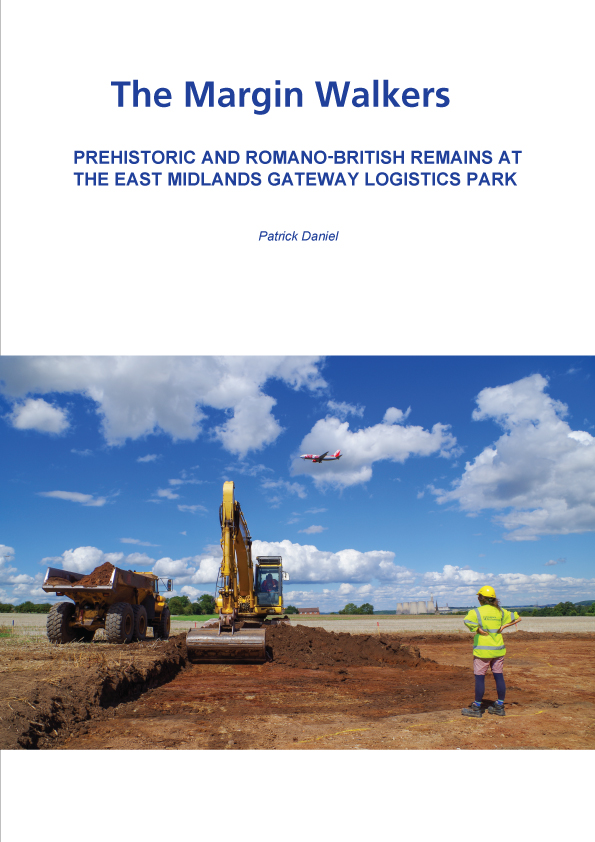The Margin Walkers: Prehistoric and Romano-British Remains at the East Midlands Gateway Logistics Park
Patrick Daniel

Description
Geophysical survey and evaluation trenching across 290 hectares of farmland in the parishes of Lockington – Hemington and Kegworth in North West Leicestershire led to the open area excavation of 12 sites (centred NGR SK 468 271). The project provided a valuable opportunity to investigate an area about which little was known archaeologically, despite it lying on the southern periphery of the Derwent/Trent/Soar confluence zone, an area rich in remains from prehistory onwards.
The work revealed relatively few indications of activity from the Bronze Age or earlier, with the earlier prehistoric evidence comprising sparse flintwork and a cluster of three Early to Middle Bronze Age burnt mounds and associated pits. A Middle Bronze Age inhumation grave and a pair of Late Bronze Age cremation graves were also found.
In keeping with regional norms, archaeologically visible activity increased dramatically during the Middle Iron Age. The excavated remains comprise pit alignments, roundhouses, field boundaries and enclosures. These sites had largely agricultural functions, characterised by mixed cattle and arable farming on a subsistence basis. Study of the animal bone and organic residue analysis of the pottery reveal dairying played a role in local farming practice. The significance of thresholds in ritual behaviour was apparent in the recovery of a human skull containing a concentration of spelt chaff placed alongside articulated horse bone in an enclosure entrance.
The use of the landscape appears to have been re-organised around the 1st century AD, with the Iron Age sites fallen or falling out of use and other areas forming foci of activity during the Romano-British period. The character of the later sites nevertheless resembled that of their Iron Age predecessors, having everyday finds assemblages and appearing small and chiefly agricultural in nature, albeit with slight evidence of agricultural intensification and an increased emphasis on exports following the Roman Conquest. After the abandonment of these sites in the 4th century AD, the land was given over to farming, with no evidence of its re-occupation until the 19th century. However, several examples of ancient boundaries persisting into the modern landscape point to some degree of continuity in the post-Roman period.
The fact that all of the excavated sites have been investigated and reported upon to a common methodology and lie in close proximity to each other means that the results represent a coherent ‘package’, perhaps more than the sum of its parts in terms of contributing to archaeological knowledge. In particular, insights have been gained into aspects of settlement form and layout, the use of pottery, trading links and agricultural practice, and how the sites fitted into the wider social and economic landscape in the centuries either side of the BC/AD transition.
Details
| Published | Published By | Pages | ISBN | ||||||||||||||||||||||||||||||||||||||||||||||||||||||||||||||||||||||||||||||||||||||||||||||||
|---|---|---|---|---|---|---|---|---|---|---|---|---|---|---|---|---|---|---|---|---|---|---|---|---|---|---|---|---|---|---|---|---|---|---|---|---|---|---|---|---|---|---|---|---|---|---|---|---|---|---|---|---|---|---|---|---|---|---|---|---|---|---|---|---|---|---|---|---|---|---|---|---|---|---|---|---|---|---|---|---|---|---|---|---|---|---|---|---|---|---|---|---|---|---|---|---|---|---|---|
| May 17, 2023 | Wessex Archaeology | 202 | 978-1-7391876-1-3 | ||||||||||||||||||||||||||||||||||||||||||||||||||||||||||||||||||||||||||||||||||||||||||||||||
| License Information | |||||||||||||||||||||||||||||||||||||||||||||||||||||||||||||||||||||||||||||||||||||||||||||||||||
| Copyright © Wessex Archaeology. This work is openly licensed via CC BY-NC-ND 4.0 | |||||||||||||||||||||||||||||||||||||||||||||||||||||||||||||||||||||||||||||||||||||||||||||||||||
